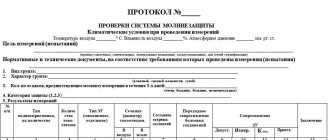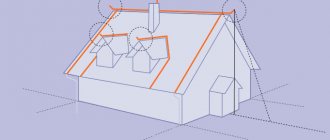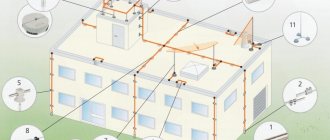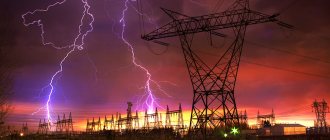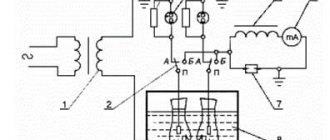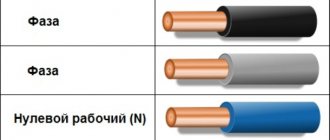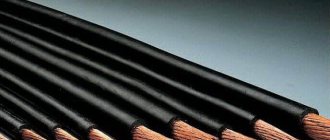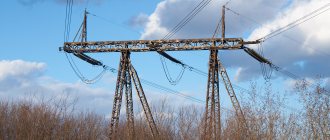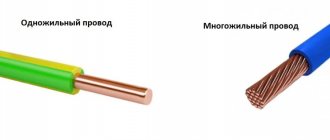Lightning is considered one of the most dangerous natural phenomena. In fact, it is an electric current in concentrated form, formed in air with high humidity and a simultaneous sharp temperature change. The emitted discharges have enormous destructive power and are capable of hitting objects until they are completely destroyed. Quite often, a sharply increasing electrodynamic voltage leads to the explosion of individual structural elements. In this regard, lightning protection of buildings and structures, which includes a whole range of different measures, is of great importance.
The need for lightning protection
Almost everyone knows that lightning protection is necessary, especially owners of private houses. Those who neglect these measures sooner or later expect serious material damage and possible injury from electric current to people living or working at the site.
Most often, lightning strikes lead to the following negative consequences:
- Buildings, structures, utility networks and communications are partially or completely destroyed.
- Electrical appliances and equipment in the affected area fail. Electrical installations are damaged and in many cases they cannot be repaired or restored.
- People and animals who were inside or near an object struck by lightning are injured and killed.
As already noted, any lightning is a powerful electrical discharge that easily destroys most structures. They cause serious damage to power lines, appliances and equipment. Entering the lower layers of the atmosphere, lightning strikes the highest point located in the danger zone. Therefore, a high-quality lightning rod, properly manufactured and installed, is quite capable of protecting objects and people in them from mortal danger and mechanical destruction.
Thunderclouds form against the backdrop of sudden temperature changes and high air humidity. Under these conditions, the atmosphere begins to fill with clouds with negative charges. Electrostatic induction occurs between the thunderstorm front and the surface of the earth, which leads to a discharge according to the principle of a capacitor. Gradually, the electric field strength increases, and tall objects, creating ionization of the air, reduce its resistivity and thereby give an impetus to lightning to strike.
These same physical properties were used when one or another lightning protection system was developed, receiving a strike and discharging high currents into the ground. At the same time, fires, mechanical damage and other negative consequences are completely excluded. Design and installation are carried out on the basis of regulatory documents - PUE, section “Lightning protection of buildings and structures”, SNiP 3.05.06-85, instruction RD 34.21.122-87 and GOST R IEC 62561.2-2014. They also determine the basic requirements for lightning protection.
Protection of metal buildings
According to the accepted classification, metal buildings are those whose design involves the use of steel columns or beams as load-bearing elements. This category also includes buildings or enterprises constructed using technology using so-called “sandwich panels”.
According to current regulations, it is recommended, whenever possible, to use natural conductive structures as open lightning protection elements for industrial buildings. This wish applies not only to down conductors and grounding conductors, but also to lightning rods.
It should be noted that metal bases and steel antenna posts, as well as floodlight masts mounted on fences and parapets, are often used as lightning rods on industrial buildings and structures. This list of lightning protection structures should be supplemented with steel stairs rising above the roof.
The function of down conductors in such buildings can be performed by load-bearing metal columns or metallized coatings used in the installation of sandwich panels (provided they have a sufficient cross-section). In such situations, I usually use reinforced concrete or steel foundation piles that have reliable contact with the ground as natural grounding conductors.
The installation of high-quality and effective lightning protection systems for city buildings and industrial structures, of course, has its own specifics.
However, the general principles of their organization, as well as the functional composition of the structural elements of lightning protection devices, practically do not differ from standard developments and projects.
The only thing you should pay attention to during their design and practical application is the possibility of using natural conductive parts of the structure as separate elements of the lightning protection itself
Damaging factors of lightning
In order to fully understand the danger of lightning strikes, it is necessary to become more familiar with its damaging factors. They must be taken into account when designing lightning protection devices for buildings and structures. At the moment of discharge, the overwhelming majority of thunderclouds have a negative polarity, while positive charges are inducted on the ground.
On average, each cloud before the start of the discharge has the following characteristics:
- Near the surface of the earth, the cloud has an electric field strength in the range of 5-300 kV/m.
- The potential ranges from 100 million to 1 billion volts.
- A single discharge of a cloud occurs in the interval from 15x10-6 to 10-3 seconds; a complete discharge requires 1.13 seconds.
- Directly in the lightning channel, a temperature of 20 thousand degrees or more is formed.
- The amplitude current value is 50 kA, in some cases up to 250 kA.
The effect of electrical discharges can be primary or secondary, depending on the damaging factors. They are taken into account when creating a lightning protection system for buildings. The primary damaging factor is a direct lightning strike to a specific object. The main consequences are fires and mechanical damage to buildings and structures.
Secondary damaging factors, of which there are several types, are manifested in the following:
- Electrostatic induction. Induced electrical potentials arise on metal structures isolated from the ground. Their appearance is associated with a high-tension static field between thunderclouds and the ground. As a result, sparking occurs between equipment parts and metal structures.
- Electromagnetic induction. On metal pipes, air ducts and other long elements with open circuits, an emf is induced at the moment of discharge. This phenomenon occurs under the influence of a powerful magnetic field that changes over time. As a consequence, sparking also occurs here in places where metal structures are located as closely as possible.
- High potentials that can enter the building through communications and metal structures located outside the facility. All this must be taken into account during construction at the design stage.
Types of lightning rods
Urban industrial and multi-storey residential buildings mainly differ in the roofing material. The roof of a building has a decisive influence on the choice of the type of lightning receiver for lightning protection.
In accordance with the requirements for the level of protection of various roofs, all known passive lightning rods are divided into the following classes:
- pin or peak devices installed on a ridge or on a separate mast;
- cable receivers, made in the form of thick wire, stretched along the ridge and along the perimeter of the roof;
- and, finally, the so-called “mesh” lightning rods, which are a large-mesh mesh laid over the entire surface of the roof and secured to special insulators.
Lightning pin receivers are most often used on metal roofs with coverings made of metallized tiles, standard corrugated sheets or corrugated sheets. They are made in the form of a steel rod of a certain length, attached to the highest point of the roof and having a special contact for connecting a down conductor.
The so-called “rope” lightning rods are made in the form of a thick and well-tensioned steel wire, which also has an outlet for connection to the grounding conductor (via a down conductor). Such devices are most often used on roofs made of traditional slate or ceramic tiles.
When installing mesh lightning rods, usually installed on soft and flat roofs of buildings, the entire protected surface is covered with a special network of thin steel conductors. The cell size of such mesh lightning protection is selected depending on the category of the building and the expected lightning activity in the area.
Categories of lightning protection of buildings and structures
According to instructions RD 34.21.122-87 and GOST, all types of buildings and structures are divided into three categories or groups in accordance with the required lightning protection measures. To distribute objects into each of them, there are certain rules, factors, norms and requirements. In addition, a meteorological map is used. First of all, the significance of each structure, its purpose, the presence of flammable and explosive substances, location, frequency of lightning strikes, and others are taken into account.
First category
Includes buildings and structures that require the highest level of protection. These are mainly objects with a high probability of explosions. The main components of protective systems are rod or cable lightning rods installed at a certain distance from each other. Of great importance is the correct calculation of the ground electrode, which can be artificial, made of metal structures, or existing reinforced concrete products are used for these purposes.
Second category
Also contains buildings containing explosive substances. This also includes some types of outdoor technological structures, open-type fuel and lubricant warehouses, rooms with flammable liquids, etc. Buildings of this category must be reliably protected from direct discharges, as well as from the introduction of electric current through overhead and underground communications, or as a result of electromagnetic induction.
The lightning rod for such objects is a metal mesh, the cell pitch of which has certain dimensions. In some cases, depending on specific conditions, rod or cable structures may be installed.
Third category
This group includes buildings located in areas where thunderstorms last more than 20 hours throughout the year. All protective measures are carried out within the 2nd category. They are aimed at protecting against direct hits and the introduction of high potentials from outside.
In some cases, lightning protection of buildings and structures is not required. The only condition is the presence of a roof that can serve as a natural lightning rod. To do this, the thickness of the steel roof must be 4 mm, copper - 5 mm, aluminum 7 mm and above.
PUE (seventh edition)
Separate paragraphs of the PUE stipulate that switchgear and 20-750 kV open-type transformer substations must be equipped with lightning rods. For some types of structures, the absence of special lightning protection is allowed, but only under the condition of a limited duration of thunderstorms throughout the year (no more than 20 hours).
The same closed structures require lightning protection only in areas with a thunderstorm duration index of more than 20.
Grounding
In the case where closed buildings have a metal roof, lightning protection is carried out using grounding devices connected directly to the roofing. If the roofing is made of reinforced concrete slabs, then if there is good contact between the individual elements of the building, grounding through the reinforcement included in them is allowed.
Protection of closed switchgear and transformer substations buildings is carried out either using rod-type lightning rods or by laying a special metal mesh.
Rod and mesh protection
When installing standard lightning rods on a protected structure, at least 2 down conductors are laid from each of them towards the grounding conductor, located on different sides of the building.
A specially designed lightning protection mesh, laid on top of the roof on special holders, is made of steel wire with a diameter of 6-8 millimeters.
For hidden installation, according to the PUE, such a lightning rod is placed under the roofing (on a layer of insulating or waterproofing material with non-flammable properties).
The protective structure, made in the form of a mesh, should consist of cells with an area of no more than 12x12 meters, and its nodes are recommended to be fixed by welding.
Down conductors or descents used to connect the lightning protection mesh to the charger must be installed along the perimeter of the building every 25 meters (at least).
Active and passive lightning protection
Different types of external lightning protection are a system consisting of conductive structures, some of which are installed in the upper part of objects. They intercept a lightning bolt and then release its high energy into the ground. The effect of such protection depends on the number of components and the coverage density of the hazardous area, and on the architectural features of a particular building. All processes here occur naturally, therefore such standard systems represent passive lightning protection.
Typically, it includes the following components:
- Lightning rod. Attracts to itself and receives electrostatic atmospheric discharge. Structurally, the design options come in the form of metal rods, cables stretched between supports or a receiving mesh with a set cell pitch. The latter option is used mainly on flat roofs with large areas.
- Down conductors. They seem to play a secondary role, but without them it is completely impossible to remove high currents that enter the lightning rod. They are made of thick steel wire with a diameter of 8 mm or more. This cross-section ensures the safe passage of large potentials within a short period of time.
- Grounding and lightning protection. They are used together and consist of individual grounding electrodes or an entire system that combines several electrodes into a single grounding loop. Down conductors can be connected to an existing grounding, but for this you will need to connect special arresters to the circuit.
Lightning protection system design
The lightning protection system is installed on a fully constructed building, in the building structures section. For the correct installation of lightning protection, a project is developed by a licensing organization. The project calculates the number of lightning protection devices and the correctness of their installation. Next, based on the design, lightning protection is installed and subsequent tests are carried out with acceptance into operation.
The components of the lightning protection system are:
Lightning rod. The task of which is to intercept the electrical discharge of lightning at the top point of the building. There are 3 types of lightning rod design: mesh, rod, cable structure. Next, the electric charge from the lightning is transferred to the down conductor.
Down conductor. The task of which is to connect the lightning rod and the ground electrode to transmit to the latter a discharge of electricity from a lightning strike. The current conductor is a metal conductor with low resistance and low heating temperature when an electric current passes. The minimum diameter of a round down conductor is 6 mm or more. To connect the down conductor, welding seams and bolted connections are usually used. The number of connections on the down conductor should be minimal. Down conductors may be laid in the middle of the building and outside. The down conductor elements are laid along the shortest path to the ground electrode.
Ground electrode. The task of which is to transmit electric current from the down conductor to the ground. It is carried out in the form of one or several conductors lowered into the ground to the calculated depth. Protected from corrosion by special materials. It is allowed to connect the building's household grounding and lightning protection grounding.
Types of lightning rods
In protection systems, natural lightning rods are used as much as possible, based on existing structural elements. If they do not give the desired effect, artificial lightning rods are used, which in most cases play a key role. They are simple to use and do not require special technical equipment. maintenance, but at the same time guarantee reliable passive protection against high current charges caused by lightning strikes.
All lightning rods rules and regulations are conventionally divided into three main types. Rod structures (Fig. 1) are made in the form of a vertical metal mast, with a height of 1 to 20 meters. They are installed directly on the roof or near the building. In the latter case, the protective zone must cover the protected object.
Using clamps, they are fixed to any surface - vertical and horizontal. Each mast is connected to two down conductors, which, in turn, are connected to the ground loop. Rod-type devices protect mainly small buildings with a simple architectural design.
A cable lightning rod (Fig. 2) is a structure that includes two masts and a steel cable stretched between them. The ends of the cable are connected to their down conductors and then to grounding conductors. The correct location of all components ensures that electrical discharges escape into the ground beyond the outer boundaries of the building. Cable devices, just like rod devices, can be single, double or multiple, completely enveloping and protecting the object. A multiple system is installed in large buildings or several structures located over a large area.
To make an air-termination mesh (Fig. 3), metal wire or rod is used. It is laid on the roof surface with a cell pitch from 5x5 m to 20x20 m in accordance with the protection category of the given object. If the roof is made of non-combustible materials, the mesh can be laid directly on it. Otherwise, a distance of at least 10 cm must be maintained.
Fastener clamps may come into contact with walls made of combustible materials if the elevated temperature does not pose any danger to them. Installation of down conductors is carried out along the entire perimeter at a distance of 10-25 meters from each other, in accordance with the level of protection of the building.
Lightning rod device
Any lightning rod consists of three main elements: a lightning receiver, conductor conductors (usually made of copper or steel) and a clamping circuit that transmits the accumulated charge into the ground to a depth of one and a half to three meters. The simplest type of such a device is a metal mast. The support posts of lightning protection devices are usually made in the form of steel pipes of the same diameter, as well as columns made of wood or reinforced concrete. Current-carrying parts of lightning removal devices are often attached to the structural elements of the structures themselves. Lightning traps on rod-type lightning rods are made of steel and must be at least 20 centimeters high.
Lightning rod (lightning rod) - device number 1 for protecting buildings from lightning
Cable lightning rods are also called linear; they are a wire stretched between a pair of iron masts. Such a device allows you to collect all lightning strikes entering the protection field. Linear lightning rods are connected to the ground loop with a large-diameter copper cable or simple metal fittings.
Linear lightning rod diagram
On high-rise buildings, a metal or reinforced concrete frame is often installed as a down conductor.
Note! It is imperative to establish a reliable connection (provided by the snip) for all frame elements. Balcony railings, emergency evacuation stairs and other metal structural elements can also serve as down conductors.
Conductor conductors are attached to the wall surfaces of structures using plastic clips; you can also use a cable channel, which will help increase the service life of the lightning conductor. When planning construction, it is necessary to provide for the presence of grounding loops with a pitch of 20-30 meters along the entire perimeter of the building.
Installation of lightning protection down conductors
Any lightning protection will not work normally if there are no down conductors and their correct placement relative to each other. It is through them that the electric current leaves the receiver and, entering the ground electrode, spreads in the ground. There are regulatory documents that determine the number and material of down conductors, their optimal cross-section and distances between lines. All this data is used when drawing up lightning protection projects.
The installed down conductor must meet the following requirements:
- After a lightning strike, the current must flow to the ground in several parallel paths.
- The current flows along the shortest path. The down conductor is installed in a straight vertical position, excluding any loops and sharp turns.
- The distances from down conductors to windows and doors must ensure the required level of safety.
The number of current-carrying lines is determined primarily by the size of the building and the type of its roof. If the perimeter of the object is less than 20 meters, then one down conductor is sufficient. When using several elements, they are distributed evenly along the entire perimeter, starting from any corner.
The simplest lightning protection consists of two down conductors located in parallel and uniformly discharging large currents to the ground. They are laid in a straight line, without bends or sharp corners, to prevent sparks, which pose a serious danger. The total number of lines is calculated for each specific case, the minimum distance is 10 m. The distance from windows and doors must be at least 50 cm.
Operation of the lightning protection system.
After installing the lightning protection system, the installation organization checks the operability of the system, connecting all elements and grounding conductors. After putting lightning protection into operation, it is necessary to inspect this system once a year, before the start of a thunderstorm period. Checking of grounding conductors is also provided.
Installation in a private house or country house is the responsibility of the owner. His safety and property. Fires from lightning strikes do not occur as often as from other causes. But if lightning strikes a building or structure, then you cannot escape from its damaging factors if you do not have lightning protection.
If you are concerned about your health and property, then our advice is to contact competent specialists to calculate the probability of a lightning strike on a building, and based on the calculation result, select and install a lightning protection device.
Tags: sconce, type, harm, choice, house, , grounding, cable, how, category, design, circuit, , magnet, lightning protection, installation, potential, rule, principle, check, wire, project, start-up, , size, calculation, reversal, row, network, connection, resistance, means, term, ten, type, current, shield, electricity, effect
Lightning protection grounding device
Grounding loops are located at a distance of at least 1 meter from the object itself, paths and other places where people frequently appear. This requirement allows us to avoid the step voltage that arises during the process of spreading the charge over the ground.
If the facility has a massive reinforced concrete foundation, the grounding should be located even further, and lightning arresters should be installed inside the building to protect electronic equipment. This requirement is mandatory, since part of the lightning charge falls on the foundation and other elements in contact with it - utility networks, equipment housings.
The main indicator of grounding is its resistance. If two separate circuits are used, they are connected to each other by steel conductors by welding. The circuit resistance should be minimal so that the current can easily flow to the ground. If the soil resistivity is 500 Ohms, then the standard resistance of the ground electrode will be 10 Ohms. At higher soil resistances, the following formula is used for calculations: Rз = 10 + 0.0022 (ρ – 500) Ohm, where Rз is the resistance of the ground electrode, ρ is the soil resistivity indicator.
Standard values can be obtained by replacing the soil. The old soil is removed, and soil with other parameters and characteristics is placed in a hole or trench. After this, grounding is installed in the renewed soil. In another case, chemical reagents are added to the soil that can change its performance in the desired direction.
Once the grounding is established, regular measurements of its resistance are subsequently carried out. If its performance is outside the standard range, you should install an additional pin or replace the inappropriate element. Particular attention is paid to the connections between all components of the grounding device.
Classification of objects to be protected
Why is grounding needed?
According to GOST standards, buildings and structures that must be protected from lightning strikes are divided according to the degree of danger into ordinary and special objects. Common objects are considered to be residential and administrative buildings for commercial, industrial and agricultural purposes, the height of which does not exceed 60 meters. Special facilities include instructions for lightning protection of buildings and industrial structures:
- potentially dangerous to surrounding people and buildings;
- hazardous to the environment;
- capable, in the event of a lightning strike, of causing radiation, biological or chemical contamination - emissions exceeding sanitary standards (as a rule, this applies to state-owned enterprises);
- structures with a height exceeding 60 meters, temporary shelters, playgrounds, objects under construction and others.
For such objects, a lightning protection level of at least 0.9 is established. The owner of the structure or the customer of the construction can independently set an increased reliability class for the building.
Conventional construction projects, according to GOST, have four levels of reliability of protection against direct lightning strikes:
- first (at a peak lightning current of 200 kiloamperes), reliability – 0.98;
- second (lightning current 150 kiloamperes), reliability – 0.95;
- third (current 100 kiloamperes), reliability – 0.9;
- fourth (current 100 kiloamperes), reliability – 0.8.
Grounding
The device is a metal structure buried or driven into the ground and ensuring good contact of the system with the ground. In wet soils, there is no point in equipping a ground electrode deeper than 80 cm. As a rule, a steel rod 18–20 mm or an angle 40–50 mm, or a steel strip 40 mm wide is used. The length of the ground electrode must be at least 3 meters.
The design may have the shape of a triangle or resemble an inverted letter “W”. The connection of the grounding elements is carried out by welding or bolting. The design must be reliable for many years, not weaken and have no backlash.
Important! If there is a ready-made grounding loop near the house, lightning protection for buildings can be connected to it.
Why should you turn to professionals?
Installation of such a system requires a careful and responsible approach. Any inaccuracies or errors can lead to disastrous consequences. Lightning protection of categories 1, 2, 3, performed by qualified specialists, is a guarantee:
- long and uninterrupted operation;
- maximum level of security;
- reliability;
- affordable cost;
- completing the task in a short time;
- professional determination of the level of lightning protection;
- prompt and competent installation of the system.
Finding an alternative solution and maximum quality are the main advantages of turning to specialists.
Instruction RD 34.21.122-87
In accordance with the provisions of this document, when designing buildings and structures for economic and domestic purposes, the requirements for equipping them with special lightning protection must be observed. The standards defined by this instruction do not apply to power lines, switchgear and transformer substations, as well as contact networks and communication equipment.
This document establishes the procedure for arranging lightning protection systems at constructed facilities, taking into account their placement outside and inside buildings.
In addition, it defines a list of protective measures taken in the event of reconstruction of a building or installation of additional electrical equipment in its open spaces (on the roof, in particular).
In addition to the requirements of this instruction, when designing structures for one purpose or another, the current provisions and rules established by state standards and construction regulations must be taken into account.
According to the rules prescribed in RD 34.21.122-87, all objects subject to lightning protection, in accordance with the features of their design and geographical location, are divided into 3 categories. The table, which brings together the various types of objects to be protected, their location, as well as the category assigned to them depending on this, can be found in the Appendix.
| Item No. | Buildings and constructions | Location | Type of protection zone when using rod and cable lightning rods | Lightning protection category |
| 1 | Buildings and structures or parts thereof, the premises of which, according to the PUE, belong to zones of classes B-I and B-II | Throughout the USSR | A | I |
| 2 | The same classes B-Ia, B-Ib, B-IIa | In areas with an average duration of thunderstorms of 10 hours per year or more | With the expected number of lightning strikes per year of a building or structure N<1 - A; N≤1 - B | II |
| 3 | Outdoor installations that create, according to the PUE, a class B-Ig zone | Throughout the USSR | B | II |
| 4 | Buildings and structures or parts thereof, the premises of which, according to the PUE, belong to zones of classes P-I, P-II, P-IIa | In areas with an average duration of thunderstorms of 20 hours per year or more | For buildings and structures of I and II degrees of fire resistance at 0.12 - A≤2> | III |
| 5 | Small buildings located in rural areas of III - V degrees of fire resistance, the premises of which, according to the PUE, belong to zones of classes P-I, P-II, P-IIa | In areas with an average duration of thunderstorms of 20 hours per year or more at N<0.2 | — | III (clause 2.30) |
| 6 | Outdoor installations and open warehouses, creating, according to the PUE, a zone of classes P-III | In areas with an average duration of thunderstorms of 20 hours per year or more | At 0.12 - A≤2> | III |
| 7 | Buildings and structures of III, IIIa, IIIb, IV, V degrees of fire resistance, in which there are no premises classified according to the PUE as explosion and fire hazardous class zones | Same | At 0.12 - A≤2> | |
| 8 | Buildings and structures made of light metal structures with combustible insulation (IVa degree of fire resistance), in which there are no premises classified according to the PUE as explosion and fire hazardous class zones | In areas with an average duration of thunderstorms of 10 hours per year or more | At 0.022 - A≤2> | III |
| 9 | Small buildings of III-V degrees of fire resistance, located in rural areas, in which there are no premises classified according to the PUE as zones of explosion and fire hazardous classes | In areas with an average duration of thunderstorms of 20 hours per year or more for III, IIIa, IIIb, IV, V degrees of fire resistance with N<0.1, for IVa degree of fire resistance with N<0.02 | — | III (clause 2.30) |
| 10 | Computer center buildings, including those located in urban areas | In areas with an average duration of thunderstorms of 20 hours per year or more | B | II |
| 11 | Livestock and poultry buildings and structures of III-V degrees of fire resistance: for cattle and pigs for 100 heads or more, for sheep for 500 heads or more, for poultry for 1000 heads or more, for horses for 40 heads or more | In areas with an average duration of thunderstorms of 40 hours per year or more | B | III |
| 12 | Smoke and other pipes of enterprises and boiler houses, towers and derricks for all purposes with a height of 15 m or more | In areas with an average duration of thunderstorms of 10 hours per year or more | B | III (clause 2.31) |
| 13 | Residential and public buildings, the height of which is more than 25 m higher than the average height of surrounding buildings within a radius of 400 m, as well as free-standing buildings with a height of more than 30 m, distant from other buildings by more than 400 m | In areas with an average duration of thunderstorms of 20 hours per year or more | B | III |
| 14 | Detached residential and public buildings in rural areas with a height of more than 30 m | Same | B | III |
| 15 | Public buildings of III-V degrees of fire resistance for the following purposes: pre-school institutions, schools and boarding schools, hospital hospitals, dormitories and canteens of healthcare and recreation institutions, cultural, educational and entertainment institutions, administrative buildings, train stations, hotels, motels and campsites | Same | B | III |
| 16 | Open entertainment institutions (auditoriums of open cinemas, stands of open stadiums, etc.) | Same | B | III |
| 17 | Buildings and structures that are monuments of history, architecture and culture (sculptures, obelisks, etc.) | Same | B | III |
Down conductors
This element connects the lightning rod to the ground electrode. For manufacturing, steel wire with a diameter of 6–10 mm is used; a steel strip or a half-inch water pipe is also suitable.
It is very important to make a strong and reliable connection between down conductors and lightning rods with grounding conductors. The strongest connection is considered to be a welded or bolted connection. To make the down conductor invisible on the facade, it can be painted in the color of the cladding or finishing of the house. Along the entire length of the descent it is necessary to make intermediate fastenings at a distance of 1.5 - 2 meters.
